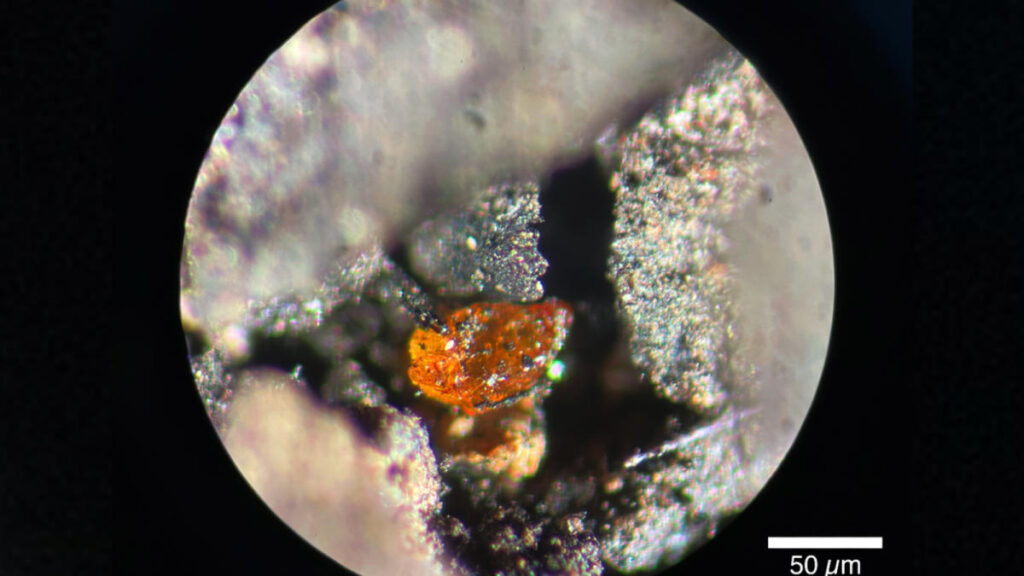For the first time, a significant discovery has been made in Antarctica involving a fragment of fossilized resin, or amber, which encapsulates remnants of a dinosaur-era rainforest that existed approximately 90 million years ago. This unprecedented finding, detailed in a recent study published in Antarctic Science, illuminates a previously uncharacterized aspect of Antarctica’s prehistoric environment. The amber, a small but notable piece measuring roughly 0.002 inches (70 micrometers) in diameter, was unearthed from sediment cores situated beneath the seafloor at a depth of about 3,100 feet (950 meters) off the coast of the Pine Island Glacier. The discovery underscores how amber, a natural time capsule formed from tree sap, can preserve various organic matter including plants and insects, offering crucial insights into ancient climates and ecosystems.
Historically, amber fossils have been identified on every continent except for Antarctica, making this new find particularly remarkable. The study indicates that during the Cretaceous period, Antarctica was characterized by warmer climatic conditions that allowed a temperate rainforest ecosystem to thrive, reminiscent of modern-day New Zealand. This ancient forest is believed to have harbored diverse life forms, including flowering plants, as evidenced by fossilized roots, pollen, and spores present in the sediment cores collected during 2017. Study lead author Johann Klages, a sedimentologist at the Alfred Wegener Institute in Germany, remarked on the significance of this discovery, emphasizing the potential it holds for exploring the intricate dynamics of past forest ecosystems.
The amber fragment was discovered during a meticulous process where researchers carefully examined numerous tiny pieces of sediment, employing fluorescent microscopy to uncover the hidden gem. Initial examinations revealed the presence of "micro-inclusions" of bark, which likely belonged to conifer-like trees that flourished in the primordial forest. Notably, the bark exhibited signs of "pathological resin flow," indicating a defensive mechanism employed by trees to protect themselves from damage, such as that caused by pests or fire. With its excellent state of preservation, despite its long burial under the seafloor, the amber represents not only a crucial remnant of its time but also a vital resource for studying ancient ecological interactions.
The uniqueness of this amber piece lies in its clarity and quality, attributes that are generally diminished under significant thermal stress and depth. Co-author Henny Gerschel, a consultant at the Saxony State Office for the Environment in Germany, noted that this particular fragment likely remained closer to the surface of the seafloor throughout its geological history, which contributed to its remarkable preservation. The findings suggest that additional amber could be present in the surrounding sediments, potentially yielding more fossils that could unveil further details about the ecosystems and species that existed in Antarctica during the Cretaceous period.
This discovery is a pivotal contribution to our understanding of Antarctica’s ecological history and serves as an important clue in piecing together the continent’s past. It helps bridge the knowledge gap about how climatic and environmental changes during the Cretaceous impacted the biodiversity and distribution of life. As researchers continue to investigate the amber fragment, they aim to uncover more information about the ancient rainforest’s composition and the types of organisms that thrived in that era. The amber is viewed as a vital artifact, providing evidence that South Polar regions were once home to lush, diverse ecosystems contrary to the barren, icy landscape they are associated with today.
In conclusion, the finding of fossilized amber in Antarctica is a groundbreaking revelation that offers tantalizing insights into the continent’s prehistoric conditions. With the potential for more discoveries stemming from this initial fragment, researchers are eager to expand their understanding of both the rainforest ecosystems that existed 90 million years ago and their implications on current biodiversity. The study of this amber and the associated finds will not only enhance our scientific comprehension of ancient climates but will also inform us about evolutionary processes that have shaped life on Earth in remarkable ways over millions of years. The journey into Antarctica’s past, now initiated by this amber discovery, continues to captivate the imagination of scientists and the public alike.

